Research Proposal: SCM in Australian Steel Industry
VerifiedAdded on 2020/05/11
|19
|4484
|273
Report
AI Summary
This research proposal focuses on supply chain risk management within the Australian Steel Manufacturing Industry, aiming to identify vulnerabilities and propose mitigation strategies. The study begins with an executive summary highlighting the importance of SCRM in modern businesses, followed by an introduction that emphasizes the significance of SCM in the contemporary business environment. A thorough literature review examines existing research on SCM, risk factors, and management techniques. The research outlines primary and secondary research questions, objectives, and sub-goals to guide the investigation. The methodology section describes theoretical content and the approach to identifying and assessing risks. The proposal also includes an experimental setup, anticipated results, and a project plan with a Gantt chart to illustrate the timeline. The research seeks to identify the risks faced by the supply chain management of a manufacturing firm while conducting its operations. The findings of the paper will be helpful for the field practitioners to increase their awareness regarding the supply chain system and the risk that are faced by the management of different organisations in the Steel manufacturing industry of Australia.
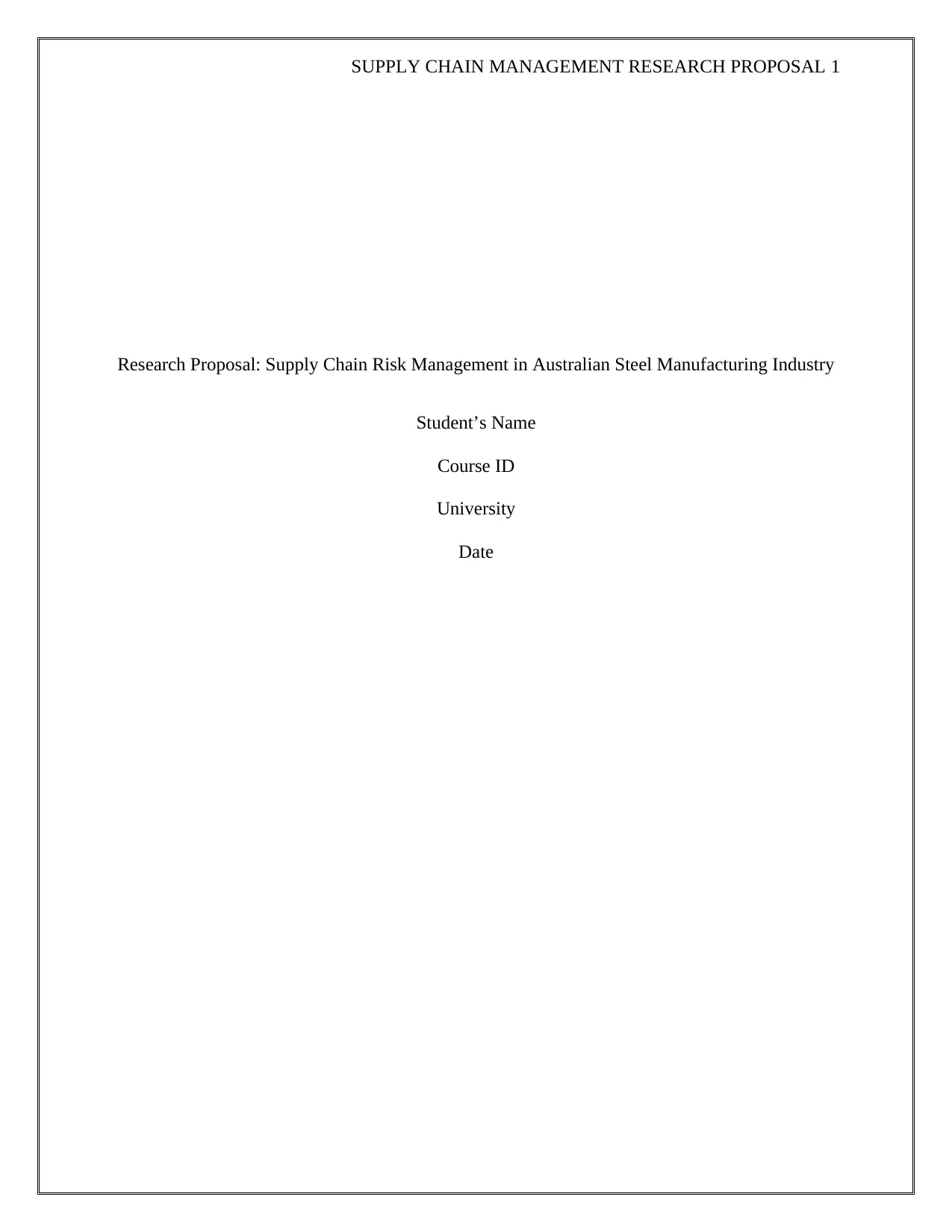
SUPPLY CHAIN MANAGEMENT RESEARCH PROPOSAL 1
Research Proposal: Supply Chain Risk Management in Australian Steel Manufacturing Industry
Student’s Name
Course ID
University
Date
Research Proposal: Supply Chain Risk Management in Australian Steel Manufacturing Industry
Student’s Name
Course ID
University
Date
Paraphrase This Document
Need a fresh take? Get an instant paraphrase of this document with our AI Paraphraser
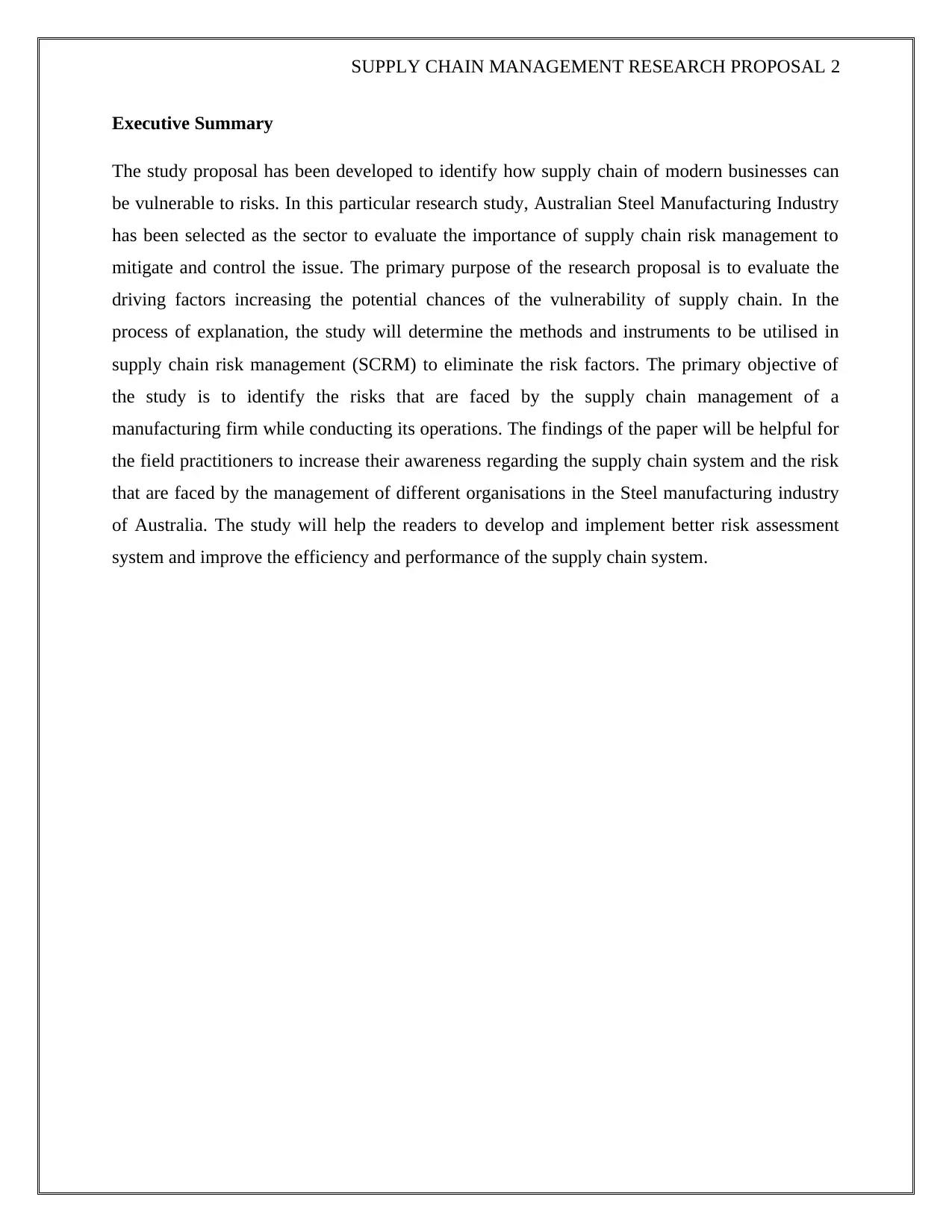
SUPPLY CHAIN MANAGEMENT RESEARCH PROPOSAL 2
Executive Summary
The study proposal has been developed to identify how supply chain of modern businesses can
be vulnerable to risks. In this particular research study, Australian Steel Manufacturing Industry
has been selected as the sector to evaluate the importance of supply chain risk management to
mitigate and control the issue. The primary purpose of the research proposal is to evaluate the
driving factors increasing the potential chances of the vulnerability of supply chain. In the
process of explanation, the study will determine the methods and instruments to be utilised in
supply chain risk management (SCRM) to eliminate the risk factors. The primary objective of
the study is to identify the risks that are faced by the supply chain management of a
manufacturing firm while conducting its operations. The findings of the paper will be helpful for
the field practitioners to increase their awareness regarding the supply chain system and the risk
that are faced by the management of different organisations in the Steel manufacturing industry
of Australia. The study will help the readers to develop and implement better risk assessment
system and improve the efficiency and performance of the supply chain system.
Executive Summary
The study proposal has been developed to identify how supply chain of modern businesses can
be vulnerable to risks. In this particular research study, Australian Steel Manufacturing Industry
has been selected as the sector to evaluate the importance of supply chain risk management to
mitigate and control the issue. The primary purpose of the research proposal is to evaluate the
driving factors increasing the potential chances of the vulnerability of supply chain. In the
process of explanation, the study will determine the methods and instruments to be utilised in
supply chain risk management (SCRM) to eliminate the risk factors. The primary objective of
the study is to identify the risks that are faced by the supply chain management of a
manufacturing firm while conducting its operations. The findings of the paper will be helpful for
the field practitioners to increase their awareness regarding the supply chain system and the risk
that are faced by the management of different organisations in the Steel manufacturing industry
of Australia. The study will help the readers to develop and implement better risk assessment
system and improve the efficiency and performance of the supply chain system.
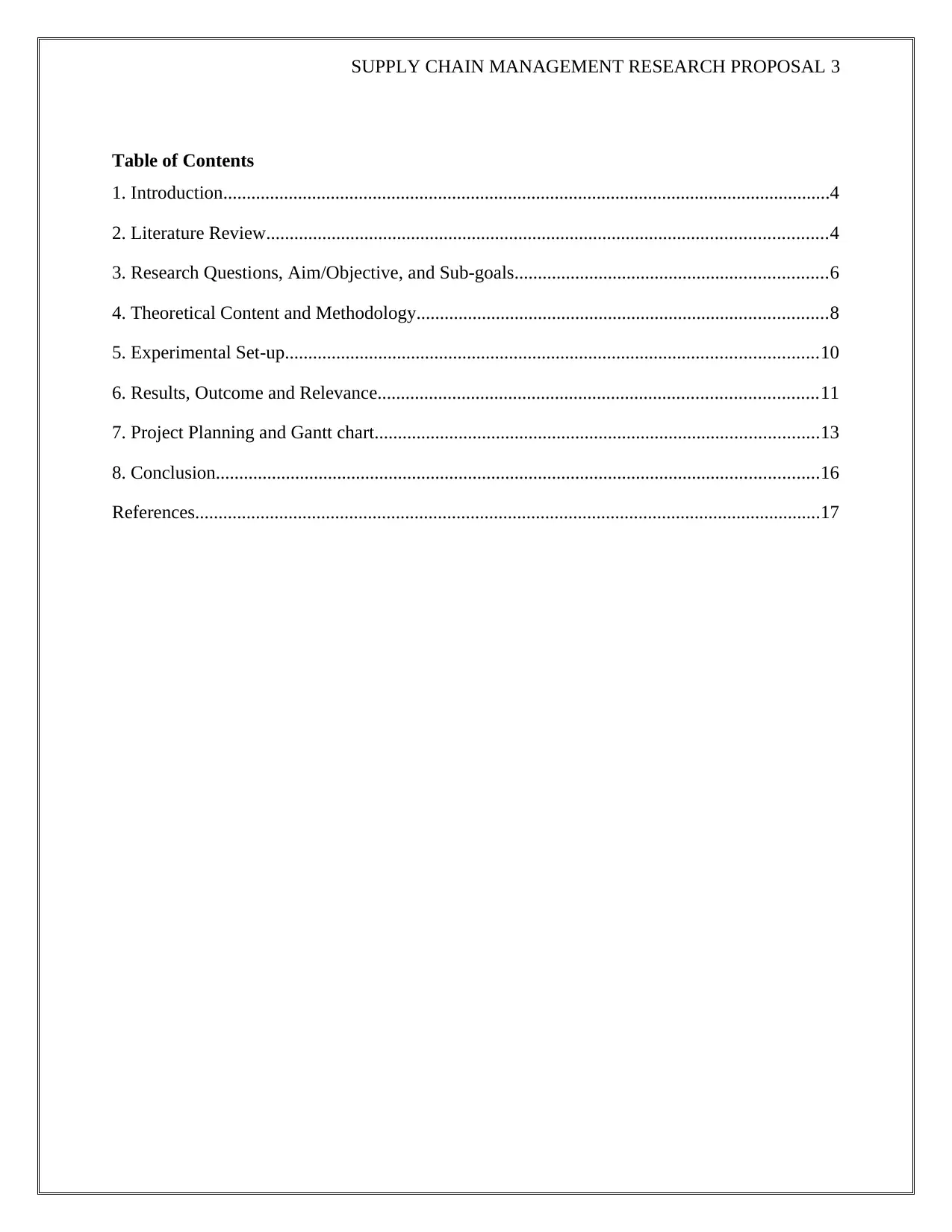
SUPPLY CHAIN MANAGEMENT RESEARCH PROPOSAL 3
Table of Contents
1. Introduction..................................................................................................................................4
2. Literature Review........................................................................................................................4
3. Research Questions, Aim/Objective, and Sub-goals...................................................................6
4. Theoretical Content and Methodology........................................................................................8
5. Experimental Set-up..................................................................................................................10
6. Results, Outcome and Relevance..............................................................................................11
7. Project Planning and Gantt chart...............................................................................................13
8. Conclusion.................................................................................................................................16
References......................................................................................................................................17
Table of Contents
1. Introduction..................................................................................................................................4
2. Literature Review........................................................................................................................4
3. Research Questions, Aim/Objective, and Sub-goals...................................................................6
4. Theoretical Content and Methodology........................................................................................8
5. Experimental Set-up..................................................................................................................10
6. Results, Outcome and Relevance..............................................................................................11
7. Project Planning and Gantt chart...............................................................................................13
8. Conclusion.................................................................................................................................16
References......................................................................................................................................17
⊘ This is a preview!⊘
Do you want full access?
Subscribe today to unlock all pages.

Trusted by 1+ million students worldwide
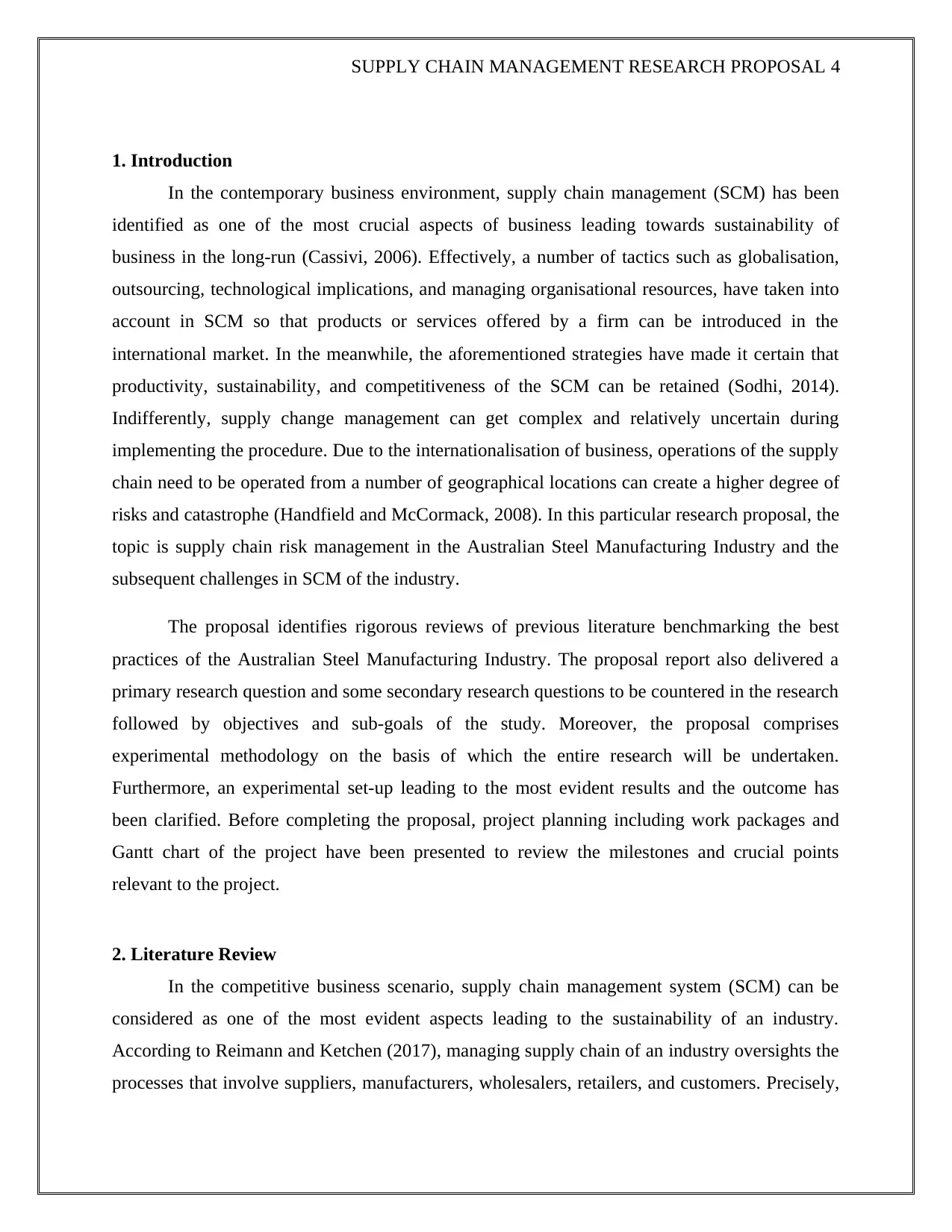
SUPPLY CHAIN MANAGEMENT RESEARCH PROPOSAL 4
1. Introduction
In the contemporary business environment, supply chain management (SCM) has been
identified as one of the most crucial aspects of business leading towards sustainability of
business in the long-run (Cassivi, 2006). Effectively, a number of tactics such as globalisation,
outsourcing, technological implications, and managing organisational resources, have taken into
account in SCM so that products or services offered by a firm can be introduced in the
international market. In the meanwhile, the aforementioned strategies have made it certain that
productivity, sustainability, and competitiveness of the SCM can be retained (Sodhi, 2014).
Indifferently, supply change management can get complex and relatively uncertain during
implementing the procedure. Due to the internationalisation of business, operations of the supply
chain need to be operated from a number of geographical locations can create a higher degree of
risks and catastrophe (Handfield and McCormack, 2008). In this particular research proposal, the
topic is supply chain risk management in the Australian Steel Manufacturing Industry and the
subsequent challenges in SCM of the industry.
The proposal identifies rigorous reviews of previous literature benchmarking the best
practices of the Australian Steel Manufacturing Industry. The proposal report also delivered a
primary research question and some secondary research questions to be countered in the research
followed by objectives and sub-goals of the study. Moreover, the proposal comprises
experimental methodology on the basis of which the entire research will be undertaken.
Furthermore, an experimental set-up leading to the most evident results and the outcome has
been clarified. Before completing the proposal, project planning including work packages and
Gantt chart of the project have been presented to review the milestones and crucial points
relevant to the project.
2. Literature Review
In the competitive business scenario, supply chain management system (SCM) can be
considered as one of the most evident aspects leading to the sustainability of an industry.
According to Reimann and Ketchen (2017), managing supply chain of an industry oversights the
processes that involve suppliers, manufacturers, wholesalers, retailers, and customers. Precisely,
1. Introduction
In the contemporary business environment, supply chain management (SCM) has been
identified as one of the most crucial aspects of business leading towards sustainability of
business in the long-run (Cassivi, 2006). Effectively, a number of tactics such as globalisation,
outsourcing, technological implications, and managing organisational resources, have taken into
account in SCM so that products or services offered by a firm can be introduced in the
international market. In the meanwhile, the aforementioned strategies have made it certain that
productivity, sustainability, and competitiveness of the SCM can be retained (Sodhi, 2014).
Indifferently, supply change management can get complex and relatively uncertain during
implementing the procedure. Due to the internationalisation of business, operations of the supply
chain need to be operated from a number of geographical locations can create a higher degree of
risks and catastrophe (Handfield and McCormack, 2008). In this particular research proposal, the
topic is supply chain risk management in the Australian Steel Manufacturing Industry and the
subsequent challenges in SCM of the industry.
The proposal identifies rigorous reviews of previous literature benchmarking the best
practices of the Australian Steel Manufacturing Industry. The proposal report also delivered a
primary research question and some secondary research questions to be countered in the research
followed by objectives and sub-goals of the study. Moreover, the proposal comprises
experimental methodology on the basis of which the entire research will be undertaken.
Furthermore, an experimental set-up leading to the most evident results and the outcome has
been clarified. Before completing the proposal, project planning including work packages and
Gantt chart of the project have been presented to review the milestones and crucial points
relevant to the project.
2. Literature Review
In the competitive business scenario, supply chain management system (SCM) can be
considered as one of the most evident aspects leading to the sustainability of an industry.
According to Reimann and Ketchen (2017), managing supply chain of an industry oversights the
processes that involve suppliers, manufacturers, wholesalers, retailers, and customers. Precisely,
Paraphrase This Document
Need a fresh take? Get an instant paraphrase of this document with our AI Paraphraser

SUPPLY CHAIN MANAGEMENT RESEARCH PROPOSAL 5
the aim of SCM is to reduce the inventory assuming that the supply chain will deliver the
products as per the requirement. In another review of literature, Holmström and Gutowski (2017)
have reviewed how additive manufacturing in a supply chain can increase the sustainability risk.
Apparently, SCM maintains coordination and integration among the involving companies.
However, additional manufacturing pressure can hinder the potentiality of SCM increasing the
cost. Probably, manufacturing industry in an economy may face the challenges associated to the
SCM that can increase the chances of vulnerability of the supply chain (Roethlein and Ackerson,
2004).
In another review of an article, Ritchie (2005) states the idea of supply chain risk
management and identifies the leading risk factors associated to SCM. In the contemporary
business scenario, companies have put more efforts on their core business capabilities whereas
manufacturing of products have shifted towards external supply networks to compete at the
international level. Historically, companies had focused on creditworthiness of a number of
suppliers to eliminate the risks from the supply chain (Kang and Hwang, 2017). In modern day
context, shorter production cycle, and efficient just-in-time strategies have contributed towards
such decision-making in SCM. Sodhi, Son, and Tang (2011), in their research study have
delivered how increased international dependencies have contributed towards complex risk
structure in supply chain in manufacturing industry. In the context of modern scenario, industries
and organisations may face manifold challenges such as raw material shortage, failure in
manufacturing units, labour strikes in production and logistic hubs, and non-compliance with a
number of standards attached to the SCM (Bredell and Walters, 2007).
In another literature review, Lemke and Petersen (2013) have discussed about the
reputational risk management methods in SCM. Safeguarding of supply chain can be identified
as one of the most evident comprehensive approaches in supply chain risk management.
Precisely, there are three stages i.e. identification of risks, analysis of risks, and managing of
risks that have led to a formidable supply chain risk management. Clearly, the implementation of
logical strategic interventions to handle the common and exceptional SCM risks will reduce the
vulnerability and viability of a supply chain (Zsidisin, 2013). In another conceptual study, Lee
(2014) has elaborated the significance of establishing a decision-making model of international
supply chain risk management to eliminate the issue of vulnerability. According to the
the aim of SCM is to reduce the inventory assuming that the supply chain will deliver the
products as per the requirement. In another review of literature, Holmström and Gutowski (2017)
have reviewed how additive manufacturing in a supply chain can increase the sustainability risk.
Apparently, SCM maintains coordination and integration among the involving companies.
However, additional manufacturing pressure can hinder the potentiality of SCM increasing the
cost. Probably, manufacturing industry in an economy may face the challenges associated to the
SCM that can increase the chances of vulnerability of the supply chain (Roethlein and Ackerson,
2004).
In another review of an article, Ritchie (2005) states the idea of supply chain risk
management and identifies the leading risk factors associated to SCM. In the contemporary
business scenario, companies have put more efforts on their core business capabilities whereas
manufacturing of products have shifted towards external supply networks to compete at the
international level. Historically, companies had focused on creditworthiness of a number of
suppliers to eliminate the risks from the supply chain (Kang and Hwang, 2017). In modern day
context, shorter production cycle, and efficient just-in-time strategies have contributed towards
such decision-making in SCM. Sodhi, Son, and Tang (2011), in their research study have
delivered how increased international dependencies have contributed towards complex risk
structure in supply chain in manufacturing industry. In the context of modern scenario, industries
and organisations may face manifold challenges such as raw material shortage, failure in
manufacturing units, labour strikes in production and logistic hubs, and non-compliance with a
number of standards attached to the SCM (Bredell and Walters, 2007).
In another literature review, Lemke and Petersen (2013) have discussed about the
reputational risk management methods in SCM. Safeguarding of supply chain can be identified
as one of the most evident comprehensive approaches in supply chain risk management.
Precisely, there are three stages i.e. identification of risks, analysis of risks, and managing of
risks that have led to a formidable supply chain risk management. Clearly, the implementation of
logical strategic interventions to handle the common and exceptional SCM risks will reduce the
vulnerability and viability of a supply chain (Zsidisin, 2013). In another conceptual study, Lee
(2014) has elaborated the significance of establishing a decision-making model of international
supply chain risk management to eliminate the issue of vulnerability. According to the

SUPPLY CHAIN MANAGEMENT RESEARCH PROPOSAL 6
researcher, a decision-making model in managing supply chain risks will deliver competitive
edge and influence the corporate image of the company. Moreover, the model can be effective to
handle regulatory challenges and compliance safeguarding the supply chain.
The previous review of literature are mostly involved the risks associated with the supply
chain risk management. Evidently, a thorough study must be done to identify how best practices
can be implemented to safeguard the SCM of an industry. Furthermore, most of the reviewed
literatures have lacked statistical analysis that has limited the results and outcome of the
research. Apart from the normative literature review, previous studies have not mentioned the
technological aspects that have influenced the performance and productivity of SCM. Therefore,
it is required to analyse the global status of SCM and the impact of technologies on modern
supply chain risk management (Handfield and McCormack, 2008). Critically, previous research
studies have primarily focused on secondary studies including random selection of journal
articles, relevant books, and conference papers. Also, operations management has been the
priority for previous studies (Borgman and Rachan, 2009). Therefore, identifying the literature
gaps will be instrumental for futuristic empirical and conceptual investigation on the topic of
supply chain risk management.
3. Research Questions, Aim/Objective, and Sub-goals
In this particular research proposal, a primary question and a number of secondary
questions have been developed that have been taken into account in conducting the research
study. Precisely, the empirical investigation will attempt to answer the following questions
providing evidence and conclusive arguments. The research questions are listed as follows:
Primary Question
RQ1. Is Supply Chain of the Australian Steel manufacturing firms vulnerable to risks in
the existing competitive business scenario?
Secondary Questions
RQ2. What are the leading risks/ drivers encountered in the aforementioned industry?
RQ3. What is the significance of Supply Chain Risk Management (SCRM) in controlling
the risk factors?
researcher, a decision-making model in managing supply chain risks will deliver competitive
edge and influence the corporate image of the company. Moreover, the model can be effective to
handle regulatory challenges and compliance safeguarding the supply chain.
The previous review of literature are mostly involved the risks associated with the supply
chain risk management. Evidently, a thorough study must be done to identify how best practices
can be implemented to safeguard the SCM of an industry. Furthermore, most of the reviewed
literatures have lacked statistical analysis that has limited the results and outcome of the
research. Apart from the normative literature review, previous studies have not mentioned the
technological aspects that have influenced the performance and productivity of SCM. Therefore,
it is required to analyse the global status of SCM and the impact of technologies on modern
supply chain risk management (Handfield and McCormack, 2008). Critically, previous research
studies have primarily focused on secondary studies including random selection of journal
articles, relevant books, and conference papers. Also, operations management has been the
priority for previous studies (Borgman and Rachan, 2009). Therefore, identifying the literature
gaps will be instrumental for futuristic empirical and conceptual investigation on the topic of
supply chain risk management.
3. Research Questions, Aim/Objective, and Sub-goals
In this particular research proposal, a primary question and a number of secondary
questions have been developed that have been taken into account in conducting the research
study. Precisely, the empirical investigation will attempt to answer the following questions
providing evidence and conclusive arguments. The research questions are listed as follows:
Primary Question
RQ1. Is Supply Chain of the Australian Steel manufacturing firms vulnerable to risks in
the existing competitive business scenario?
Secondary Questions
RQ2. What are the leading risks/ drivers encountered in the aforementioned industry?
RQ3. What is the significance of Supply Chain Risk Management (SCRM) in controlling
the risk factors?
⊘ This is a preview!⊘
Do you want full access?
Subscribe today to unlock all pages.

Trusted by 1+ million students worldwide
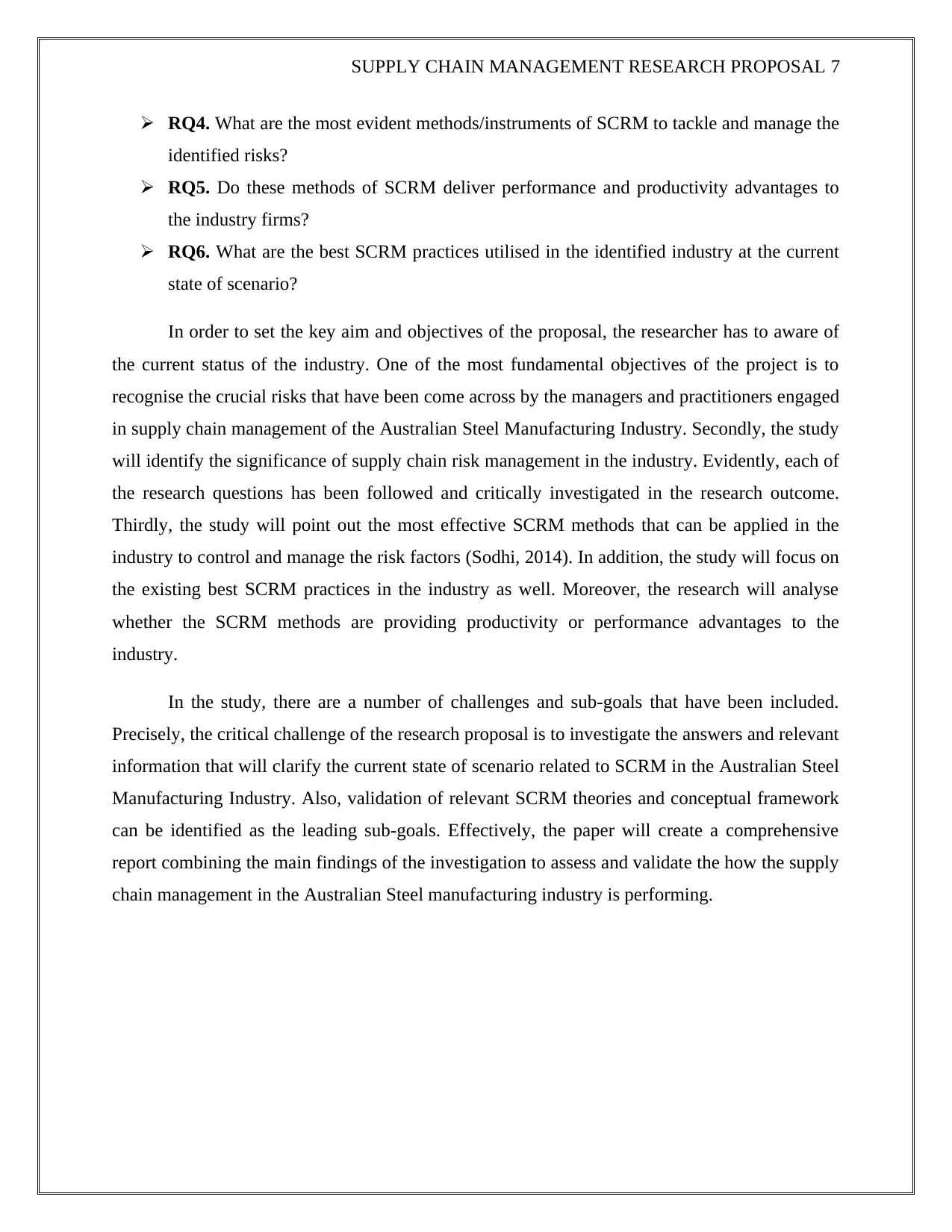
SUPPLY CHAIN MANAGEMENT RESEARCH PROPOSAL 7
RQ4. What are the most evident methods/instruments of SCRM to tackle and manage the
identified risks?
RQ5. Do these methods of SCRM deliver performance and productivity advantages to
the industry firms?
RQ6. What are the best SCRM practices utilised in the identified industry at the current
state of scenario?
In order to set the key aim and objectives of the proposal, the researcher has to aware of
the current status of the industry. One of the most fundamental objectives of the project is to
recognise the crucial risks that have been come across by the managers and practitioners engaged
in supply chain management of the Australian Steel Manufacturing Industry. Secondly, the study
will identify the significance of supply chain risk management in the industry. Evidently, each of
the research questions has been followed and critically investigated in the research outcome.
Thirdly, the study will point out the most effective SCRM methods that can be applied in the
industry to control and manage the risk factors (Sodhi, 2014). In addition, the study will focus on
the existing best SCRM practices in the industry as well. Moreover, the research will analyse
whether the SCRM methods are providing productivity or performance advantages to the
industry.
In the study, there are a number of challenges and sub-goals that have been included.
Precisely, the critical challenge of the research proposal is to investigate the answers and relevant
information that will clarify the current state of scenario related to SCRM in the Australian Steel
Manufacturing Industry. Also, validation of relevant SCRM theories and conceptual framework
can be identified as the leading sub-goals. Effectively, the paper will create a comprehensive
report combining the main findings of the investigation to assess and validate the how the supply
chain management in the Australian Steel manufacturing industry is performing.
RQ4. What are the most evident methods/instruments of SCRM to tackle and manage the
identified risks?
RQ5. Do these methods of SCRM deliver performance and productivity advantages to
the industry firms?
RQ6. What are the best SCRM practices utilised in the identified industry at the current
state of scenario?
In order to set the key aim and objectives of the proposal, the researcher has to aware of
the current status of the industry. One of the most fundamental objectives of the project is to
recognise the crucial risks that have been come across by the managers and practitioners engaged
in supply chain management of the Australian Steel Manufacturing Industry. Secondly, the study
will identify the significance of supply chain risk management in the industry. Evidently, each of
the research questions has been followed and critically investigated in the research outcome.
Thirdly, the study will point out the most effective SCRM methods that can be applied in the
industry to control and manage the risk factors (Sodhi, 2014). In addition, the study will focus on
the existing best SCRM practices in the industry as well. Moreover, the research will analyse
whether the SCRM methods are providing productivity or performance advantages to the
industry.
In the study, there are a number of challenges and sub-goals that have been included.
Precisely, the critical challenge of the research proposal is to investigate the answers and relevant
information that will clarify the current state of scenario related to SCRM in the Australian Steel
Manufacturing Industry. Also, validation of relevant SCRM theories and conceptual framework
can be identified as the leading sub-goals. Effectively, the paper will create a comprehensive
report combining the main findings of the investigation to assess and validate the how the supply
chain management in the Australian Steel manufacturing industry is performing.
Paraphrase This Document
Need a fresh take? Get an instant paraphrase of this document with our AI Paraphraser
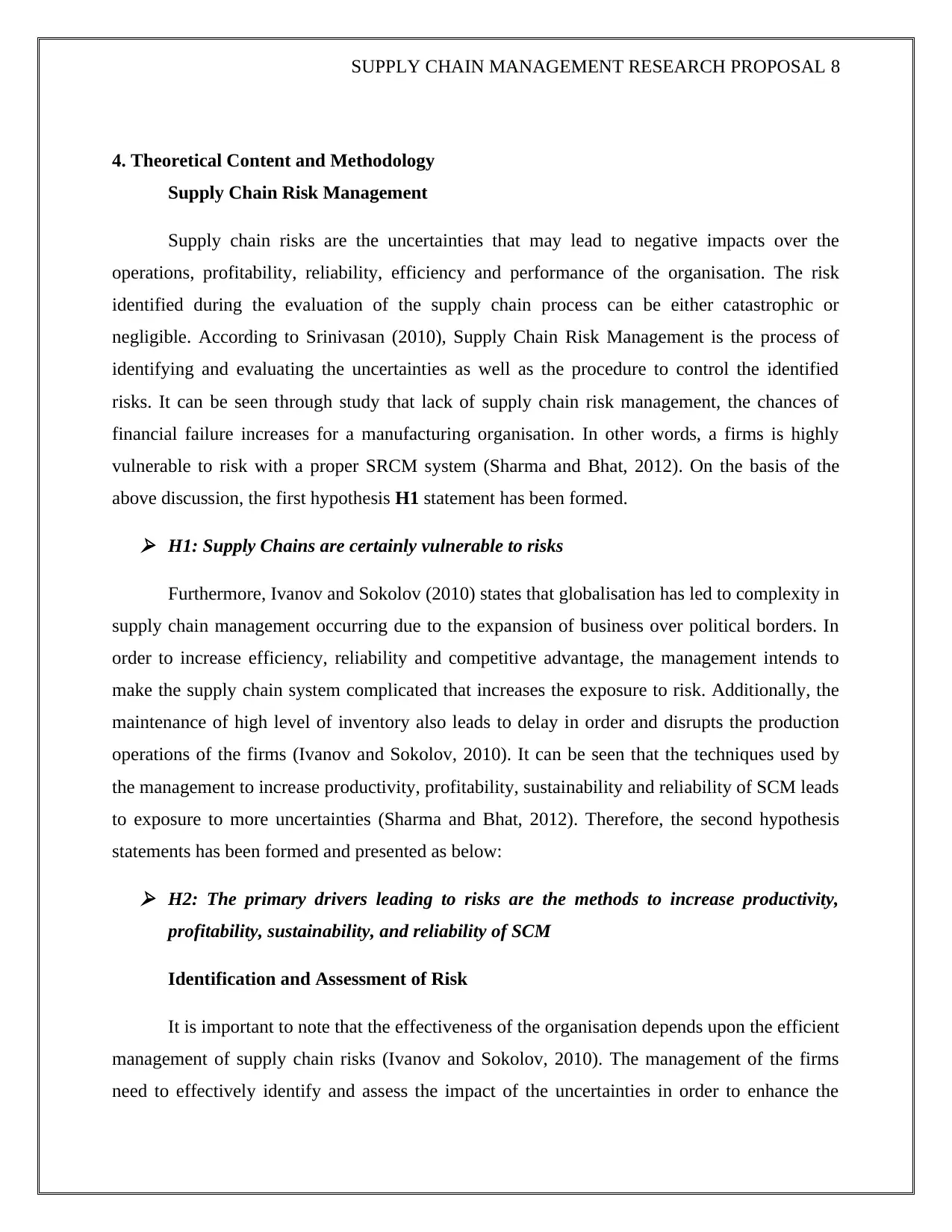
SUPPLY CHAIN MANAGEMENT RESEARCH PROPOSAL 8
4. Theoretical Content and Methodology
Supply Chain Risk Management
Supply chain risks are the uncertainties that may lead to negative impacts over the
operations, profitability, reliability, efficiency and performance of the organisation. The risk
identified during the evaluation of the supply chain process can be either catastrophic or
negligible. According to Srinivasan (2010), Supply Chain Risk Management is the process of
identifying and evaluating the uncertainties as well as the procedure to control the identified
risks. It can be seen through study that lack of supply chain risk management, the chances of
financial failure increases for a manufacturing organisation. In other words, a firms is highly
vulnerable to risk with a proper SRCM system (Sharma and Bhat, 2012). On the basis of the
above discussion, the first hypothesis H1 statement has been formed.
H1: Supply Chains are certainly vulnerable to risks
Furthermore, Ivanov and Sokolov (2010) states that globalisation has led to complexity in
supply chain management occurring due to the expansion of business over political borders. In
order to increase efficiency, reliability and competitive advantage, the management intends to
make the supply chain system complicated that increases the exposure to risk. Additionally, the
maintenance of high level of inventory also leads to delay in order and disrupts the production
operations of the firms (Ivanov and Sokolov, 2010). It can be seen that the techniques used by
the management to increase productivity, profitability, sustainability and reliability of SCM leads
to exposure to more uncertainties (Sharma and Bhat, 2012). Therefore, the second hypothesis
statements has been formed and presented as below:
H2: The primary drivers leading to risks are the methods to increase productivity,
profitability, sustainability, and reliability of SCM
Identification and Assessment of Risk
It is important to note that the effectiveness of the organisation depends upon the efficient
management of supply chain risks (Ivanov and Sokolov, 2010). The management of the firms
need to effectively identify and assess the impact of the uncertainties in order to enhance the
4. Theoretical Content and Methodology
Supply Chain Risk Management
Supply chain risks are the uncertainties that may lead to negative impacts over the
operations, profitability, reliability, efficiency and performance of the organisation. The risk
identified during the evaluation of the supply chain process can be either catastrophic or
negligible. According to Srinivasan (2010), Supply Chain Risk Management is the process of
identifying and evaluating the uncertainties as well as the procedure to control the identified
risks. It can be seen through study that lack of supply chain risk management, the chances of
financial failure increases for a manufacturing organisation. In other words, a firms is highly
vulnerable to risk with a proper SRCM system (Sharma and Bhat, 2012). On the basis of the
above discussion, the first hypothesis H1 statement has been formed.
H1: Supply Chains are certainly vulnerable to risks
Furthermore, Ivanov and Sokolov (2010) states that globalisation has led to complexity in
supply chain management occurring due to the expansion of business over political borders. In
order to increase efficiency, reliability and competitive advantage, the management intends to
make the supply chain system complicated that increases the exposure to risk. Additionally, the
maintenance of high level of inventory also leads to delay in order and disrupts the production
operations of the firms (Ivanov and Sokolov, 2010). It can be seen that the techniques used by
the management to increase productivity, profitability, sustainability and reliability of SCM leads
to exposure to more uncertainties (Sharma and Bhat, 2012). Therefore, the second hypothesis
statements has been formed and presented as below:
H2: The primary drivers leading to risks are the methods to increase productivity,
profitability, sustainability, and reliability of SCM
Identification and Assessment of Risk
It is important to note that the effectiveness of the organisation depends upon the efficient
management of supply chain risks (Ivanov and Sokolov, 2010). The management of the firms
need to effectively identify and assess the impact of the uncertainties in order to enhance the

SUPPLY CHAIN MANAGEMENT RESEARCH PROPOSAL 9
viability of the business and promote competitiveness. According to Sharma and Bhat (2012),
most of the risk in a firm is associated with the supply chain system of the business. Hence, the
management needs to focus on using modern risk identification techniques and instruments in
order to increase the viability of the business and seek competitive advantage in the market. On
the basis of the above discussion, the third hypothesis H3 has been developed that has been
presented herein below:
H3: Efficient management of Supply chain risk can influence the viability of business
and promote competitiveness
According to Srinivasan (2010), the success of the Supply Chain Management relies on
using effective supply chain management tools, practices, and instruments. In order to properly
identify the risks, the management need to develop a proper supply chain management plan. On
the basis of the above statement, the fourth hypothesis H4 has been presented below:
H4: The implementation of most effective supply chain management tools, practices,
and instruments can increase the benefits of SCM
Management and Risk Mitigation Techniques
Finally, the management must be aware of the risk mitigation techniques in order to
manage the uncertainties and avoid any sort of financial losses. As per Colicchia and Strozzi
(2012), different sorts of preventive instruments can be used to mitigate the risks. The preventive
instruments include maintenance of machinery to prevent production interruption and machine
breakdowns, and effective communication strategies to ensure proper on-time delivery from
suppliers (Colicchia and Strozzi, 2012). However, some sort of risk cannot be avoided as they
are uncertain in nature and cannot be predicted (Srinivasan, 2010). Hence, the performance of
the SCRM may depend on the preventive instruments that are used by the management. On the
basis of the above discussion, hypothesis five H5 has been presented below:
H5: The performance of SCRM may vary depending on the preventive instrument of
the system
In the current environment of increased globalisation and development of innovative
technology, the supply chain system of a firm has become complicated. In order to survive in the
viability of the business and promote competitiveness. According to Sharma and Bhat (2012),
most of the risk in a firm is associated with the supply chain system of the business. Hence, the
management needs to focus on using modern risk identification techniques and instruments in
order to increase the viability of the business and seek competitive advantage in the market. On
the basis of the above discussion, the third hypothesis H3 has been developed that has been
presented herein below:
H3: Efficient management of Supply chain risk can influence the viability of business
and promote competitiveness
According to Srinivasan (2010), the success of the Supply Chain Management relies on
using effective supply chain management tools, practices, and instruments. In order to properly
identify the risks, the management need to develop a proper supply chain management plan. On
the basis of the above statement, the fourth hypothesis H4 has been presented below:
H4: The implementation of most effective supply chain management tools, practices,
and instruments can increase the benefits of SCM
Management and Risk Mitigation Techniques
Finally, the management must be aware of the risk mitigation techniques in order to
manage the uncertainties and avoid any sort of financial losses. As per Colicchia and Strozzi
(2012), different sorts of preventive instruments can be used to mitigate the risks. The preventive
instruments include maintenance of machinery to prevent production interruption and machine
breakdowns, and effective communication strategies to ensure proper on-time delivery from
suppliers (Colicchia and Strozzi, 2012). However, some sort of risk cannot be avoided as they
are uncertain in nature and cannot be predicted (Srinivasan, 2010). Hence, the performance of
the SCRM may depend on the preventive instruments that are used by the management. On the
basis of the above discussion, hypothesis five H5 has been presented below:
H5: The performance of SCRM may vary depending on the preventive instrument of
the system
In the current environment of increased globalisation and development of innovative
technology, the supply chain system of a firm has become complicated. In order to survive in the
⊘ This is a preview!⊘
Do you want full access?
Subscribe today to unlock all pages.

Trusted by 1+ million students worldwide
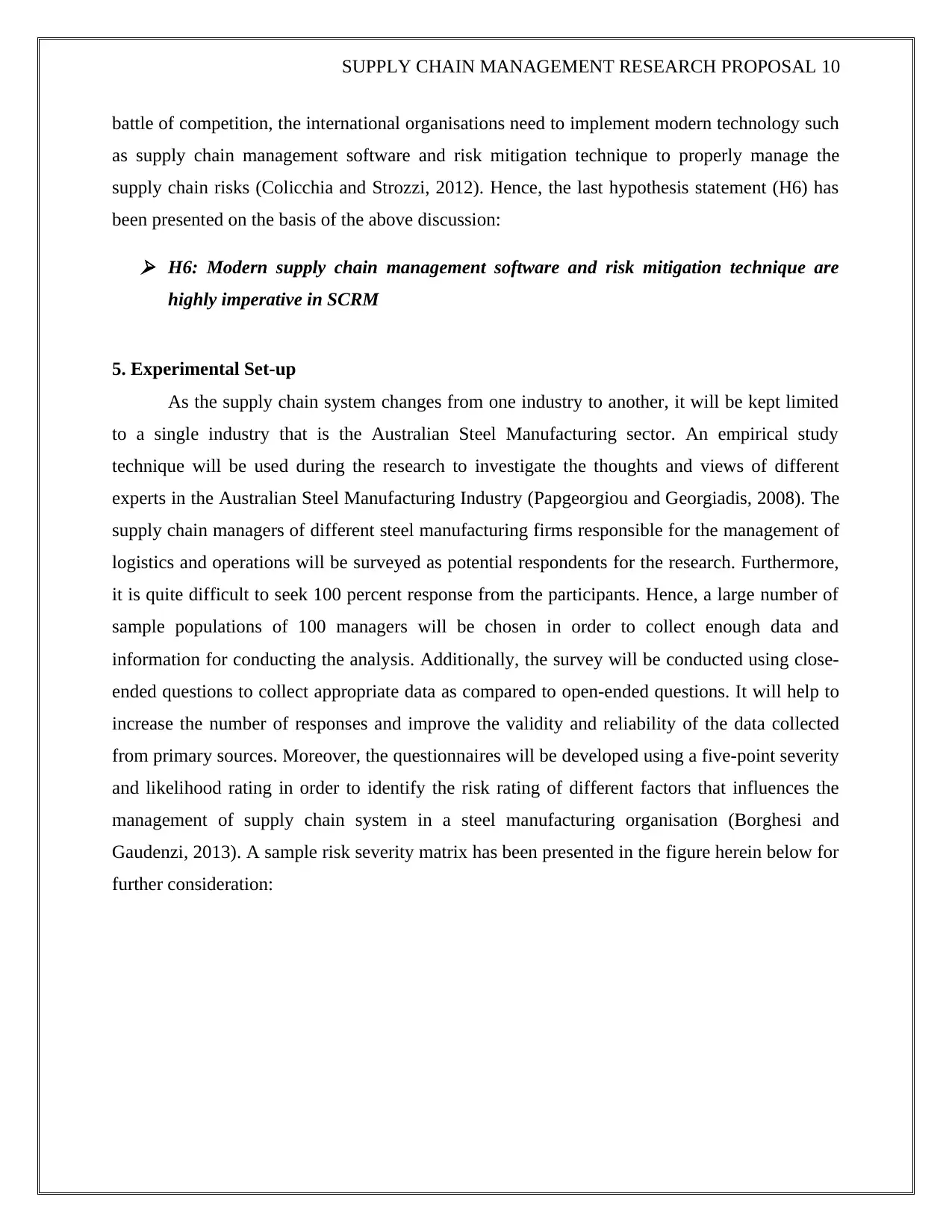
SUPPLY CHAIN MANAGEMENT RESEARCH PROPOSAL 10
battle of competition, the international organisations need to implement modern technology such
as supply chain management software and risk mitigation technique to properly manage the
supply chain risks (Colicchia and Strozzi, 2012). Hence, the last hypothesis statement (H6) has
been presented on the basis of the above discussion:
H6: Modern supply chain management software and risk mitigation technique are
highly imperative in SCRM
5. Experimental Set-up
As the supply chain system changes from one industry to another, it will be kept limited
to a single industry that is the Australian Steel Manufacturing sector. An empirical study
technique will be used during the research to investigate the thoughts and views of different
experts in the Australian Steel Manufacturing Industry (Papgeorgiou and Georgiadis, 2008). The
supply chain managers of different steel manufacturing firms responsible for the management of
logistics and operations will be surveyed as potential respondents for the research. Furthermore,
it is quite difficult to seek 100 percent response from the participants. Hence, a large number of
sample populations of 100 managers will be chosen in order to collect enough data and
information for conducting the analysis. Additionally, the survey will be conducted using close-
ended questions to collect appropriate data as compared to open-ended questions. It will help to
increase the number of responses and improve the validity and reliability of the data collected
from primary sources. Moreover, the questionnaires will be developed using a five-point severity
and likelihood rating in order to identify the risk rating of different factors that influences the
management of supply chain system in a steel manufacturing organisation (Borghesi and
Gaudenzi, 2013). A sample risk severity matrix has been presented in the figure herein below for
further consideration:
battle of competition, the international organisations need to implement modern technology such
as supply chain management software and risk mitigation technique to properly manage the
supply chain risks (Colicchia and Strozzi, 2012). Hence, the last hypothesis statement (H6) has
been presented on the basis of the above discussion:
H6: Modern supply chain management software and risk mitigation technique are
highly imperative in SCRM
5. Experimental Set-up
As the supply chain system changes from one industry to another, it will be kept limited
to a single industry that is the Australian Steel Manufacturing sector. An empirical study
technique will be used during the research to investigate the thoughts and views of different
experts in the Australian Steel Manufacturing Industry (Papgeorgiou and Georgiadis, 2008). The
supply chain managers of different steel manufacturing firms responsible for the management of
logistics and operations will be surveyed as potential respondents for the research. Furthermore,
it is quite difficult to seek 100 percent response from the participants. Hence, a large number of
sample populations of 100 managers will be chosen in order to collect enough data and
information for conducting the analysis. Additionally, the survey will be conducted using close-
ended questions to collect appropriate data as compared to open-ended questions. It will help to
increase the number of responses and improve the validity and reliability of the data collected
from primary sources. Moreover, the questionnaires will be developed using a five-point severity
and likelihood rating in order to identify the risk rating of different factors that influences the
management of supply chain system in a steel manufacturing organisation (Borghesi and
Gaudenzi, 2013). A sample risk severity matrix has been presented in the figure herein below for
further consideration:
Paraphrase This Document
Need a fresh take? Get an instant paraphrase of this document with our AI Paraphraser

SUPPLY CHAIN MANAGEMENT RESEARCH PROPOSAL 11
Figure: Risk Severity Matrix
Source: (Borghesi and Gaudenzi, 2013)
6. Results, Outcome and Relevance
In the results and outcome section, a summary of relevance between the Research
questions and hypotheses has been presented in a table format as follows:
Table: Summary of research questions and Hypotheses
Research Questions Relevant Hypotheses
Q1. Is Supply Chain of the Australian Steel
manufacturing firms vulnerable to risks in
the existing competitive business scenario?
H1: Supply Chains are certainly vulnerable to
risks
Q2. What are the leading risks/ drivers
encountered in the aforementioned
industry?
H2: The primary drivers leading to risks are
the methods to increase productivity,
profitability, sustainability, and reliability of
SCM
Q3. What is the significance of Supply H3: Efficient management of Supply chain risk
Figure: Risk Severity Matrix
Source: (Borghesi and Gaudenzi, 2013)
6. Results, Outcome and Relevance
In the results and outcome section, a summary of relevance between the Research
questions and hypotheses has been presented in a table format as follows:
Table: Summary of research questions and Hypotheses
Research Questions Relevant Hypotheses
Q1. Is Supply Chain of the Australian Steel
manufacturing firms vulnerable to risks in
the existing competitive business scenario?
H1: Supply Chains are certainly vulnerable to
risks
Q2. What are the leading risks/ drivers
encountered in the aforementioned
industry?
H2: The primary drivers leading to risks are
the methods to increase productivity,
profitability, sustainability, and reliability of
SCM
Q3. What is the significance of Supply H3: Efficient management of Supply chain risk
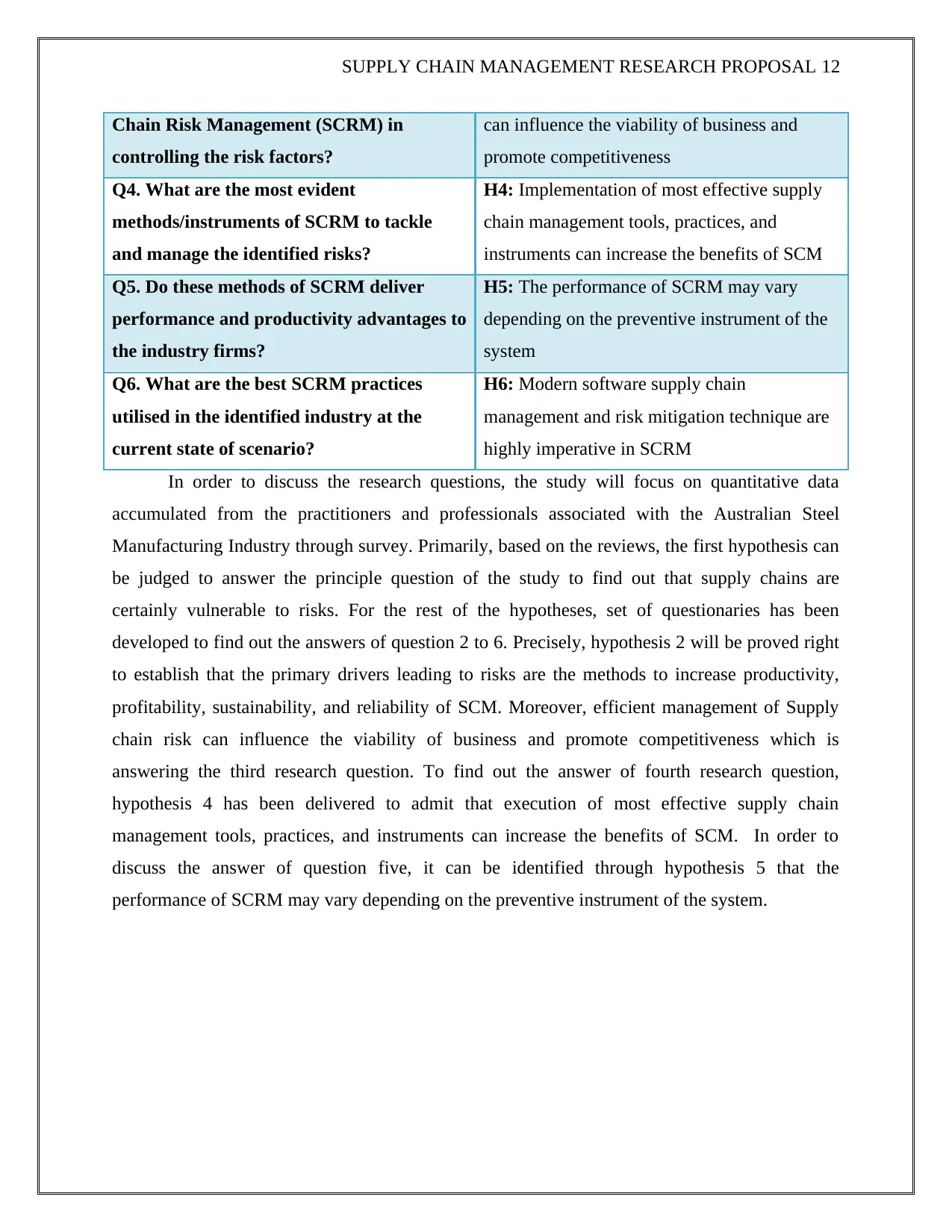
SUPPLY CHAIN MANAGEMENT RESEARCH PROPOSAL 12
Chain Risk Management (SCRM) in
controlling the risk factors?
can influence the viability of business and
promote competitiveness
Q4. What are the most evident
methods/instruments of SCRM to tackle
and manage the identified risks?
H4: Implementation of most effective supply
chain management tools, practices, and
instruments can increase the benefits of SCM
Q5. Do these methods of SCRM deliver
performance and productivity advantages to
the industry firms?
H5: The performance of SCRM may vary
depending on the preventive instrument of the
system
Q6. What are the best SCRM practices
utilised in the identified industry at the
current state of scenario?
H6: Modern software supply chain
management and risk mitigation technique are
highly imperative in SCRM
In order to discuss the research questions, the study will focus on quantitative data
accumulated from the practitioners and professionals associated with the Australian Steel
Manufacturing Industry through survey. Primarily, based on the reviews, the first hypothesis can
be judged to answer the principle question of the study to find out that supply chains are
certainly vulnerable to risks. For the rest of the hypotheses, set of questionaries has been
developed to find out the answers of question 2 to 6. Precisely, hypothesis 2 will be proved right
to establish that the primary drivers leading to risks are the methods to increase productivity,
profitability, sustainability, and reliability of SCM. Moreover, efficient management of Supply
chain risk can influence the viability of business and promote competitiveness which is
answering the third research question. To find out the answer of fourth research question,
hypothesis 4 has been delivered to admit that execution of most effective supply chain
management tools, practices, and instruments can increase the benefits of SCM. In order to
discuss the answer of question five, it can be identified through hypothesis 5 that the
performance of SCRM may vary depending on the preventive instrument of the system.
Chain Risk Management (SCRM) in
controlling the risk factors?
can influence the viability of business and
promote competitiveness
Q4. What are the most evident
methods/instruments of SCRM to tackle
and manage the identified risks?
H4: Implementation of most effective supply
chain management tools, practices, and
instruments can increase the benefits of SCM
Q5. Do these methods of SCRM deliver
performance and productivity advantages to
the industry firms?
H5: The performance of SCRM may vary
depending on the preventive instrument of the
system
Q6. What are the best SCRM practices
utilised in the identified industry at the
current state of scenario?
H6: Modern software supply chain
management and risk mitigation technique are
highly imperative in SCRM
In order to discuss the research questions, the study will focus on quantitative data
accumulated from the practitioners and professionals associated with the Australian Steel
Manufacturing Industry through survey. Primarily, based on the reviews, the first hypothesis can
be judged to answer the principle question of the study to find out that supply chains are
certainly vulnerable to risks. For the rest of the hypotheses, set of questionaries has been
developed to find out the answers of question 2 to 6. Precisely, hypothesis 2 will be proved right
to establish that the primary drivers leading to risks are the methods to increase productivity,
profitability, sustainability, and reliability of SCM. Moreover, efficient management of Supply
chain risk can influence the viability of business and promote competitiveness which is
answering the third research question. To find out the answer of fourth research question,
hypothesis 4 has been delivered to admit that execution of most effective supply chain
management tools, practices, and instruments can increase the benefits of SCM. In order to
discuss the answer of question five, it can be identified through hypothesis 5 that the
performance of SCRM may vary depending on the preventive instrument of the system.
⊘ This is a preview!⊘
Do you want full access?
Subscribe today to unlock all pages.

Trusted by 1+ million students worldwide
1 out of 19